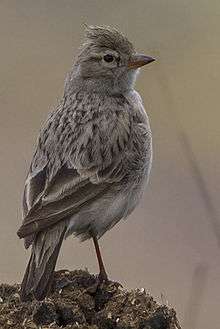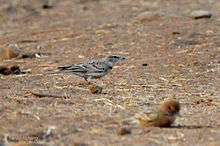Hume's short-toed lark
Hume's short-toed lark (Calandrella acutirostris) is a species of lark in the family Alaudidae. It is found in south-central Asia from Iran and Kazakhstan to China.
| Hume's short-toed lark | |
|---|---|
 | |
| From Laxman chowk, close to Pangolakha Wildlife Sanctuary, Sikkim, India | |
| Scientific classification | |
| Kingdom: | Animalia |
| Phylum: | Chordata |
| Class: | Aves |
| Order: | Passeriformes |
| Family: | Alaudidae |
| Genus: | Calandrella |
| Species: | C. acutirostris |
| Binomial name | |
| Calandrella acutirostris Hume, 1873 | |
| Subspecies | |
|
See text | |
Taxonomy and systematics
The name commemorates the British naturalist Allan Octavian Hume who described the species.[2] The alternate name short-toed lark may also be used for three other species in the genus Calandrella. The alternate name lesser short-toed lark should not be confused with the species of the same name, Alaudala rufescens. Other alternate names for Hume's short-toed lark include Hume's lark and Karakoram short-toed lark.[3]
Subspecies
Two subspecies are recognized:[4]
- C. a. acutirostris - Hume, 1873: Found from north-eastern Iran and eastern Kazakhstan to western China
- Tibet short-toed lark (C. a. tibetana) - Brooks, WE, 1880: Originally described as a separate species. Found from north-eastern Pakistan to Tibetan Plateau
Description
Hume's short-toed lark is similar in size and appearance to the greater short-toed lark but is generally a duller-looking bird with slightly darker plumage and a slightly smaller beak. As with the greater short-toed lark, the colour varies across the broad range and is not a good distinguishing feature. Hume's short-toed lark grows to a length of from 13 to 14 cm (5.1 to 5.5 in) and the sexes are similar. The crown is brown with slight diffuse streaking, the cheeks are rufous-brown and the supercilium white. The upper parts are greyish-brown or sandy brown with darker streaking, and the upper tail coverts are washed with rufous-brown. The wings are greyish-brown with black barring and pale tips to the feathers. The underparts are mostly whitish, but there is a dark neck patch and a buffish-grey breast band. The breast is unstreaked. The voice helps distinguish this species; vocalisations include a shrill "trree" and a more rolling "drreep".[5]
References
- BirdLife International (2012). "Calandrella acutirostris". IUCN Red List of Threatened Species. 2012. Retrieved 26 November 2013.CS1 maint: ref=harv (link)
- Beolens, Bo; Watkins, Michael (2003). Whose Bird? Men and Women Commemorated in the Common Names of Birds. London: Christopher Helm. pp. 173–174.
- "Calandrella acutirostris - Avibase". avibase.bsc-eoc.org. Retrieved 2016-12-11.
- "IOC World Bird List 6.4". IOC World Bird List Datasets. doi:10.14344/ioc.ml.6.4.
- Mark Beaman; Steve Madge (1998). The Handbook of Bird Identification: For Europe and the Western Palearctic. Christopher Helm. p. 547. ISBN 978-0-7136-3960-5.

_MH.jpg)
External links
| Wikimedia Commons has media related to Calandrella acutirostris. |
| Wikispecies has information related to Calandrella acutirostris |
- BirdLife species factsheet for Calandrella acutirostris
- "Calandrella acutirostris". Avibase.

- "Hume's lark media". Internet Bird Collection.
- Hume's lark photo gallery at VIREO (Drexel University)
- Interactive range map of Calandrella acutirostris at IUCN Red List maps
- Audio recordings of Hume's short-toed lark on Xeno-canto.
